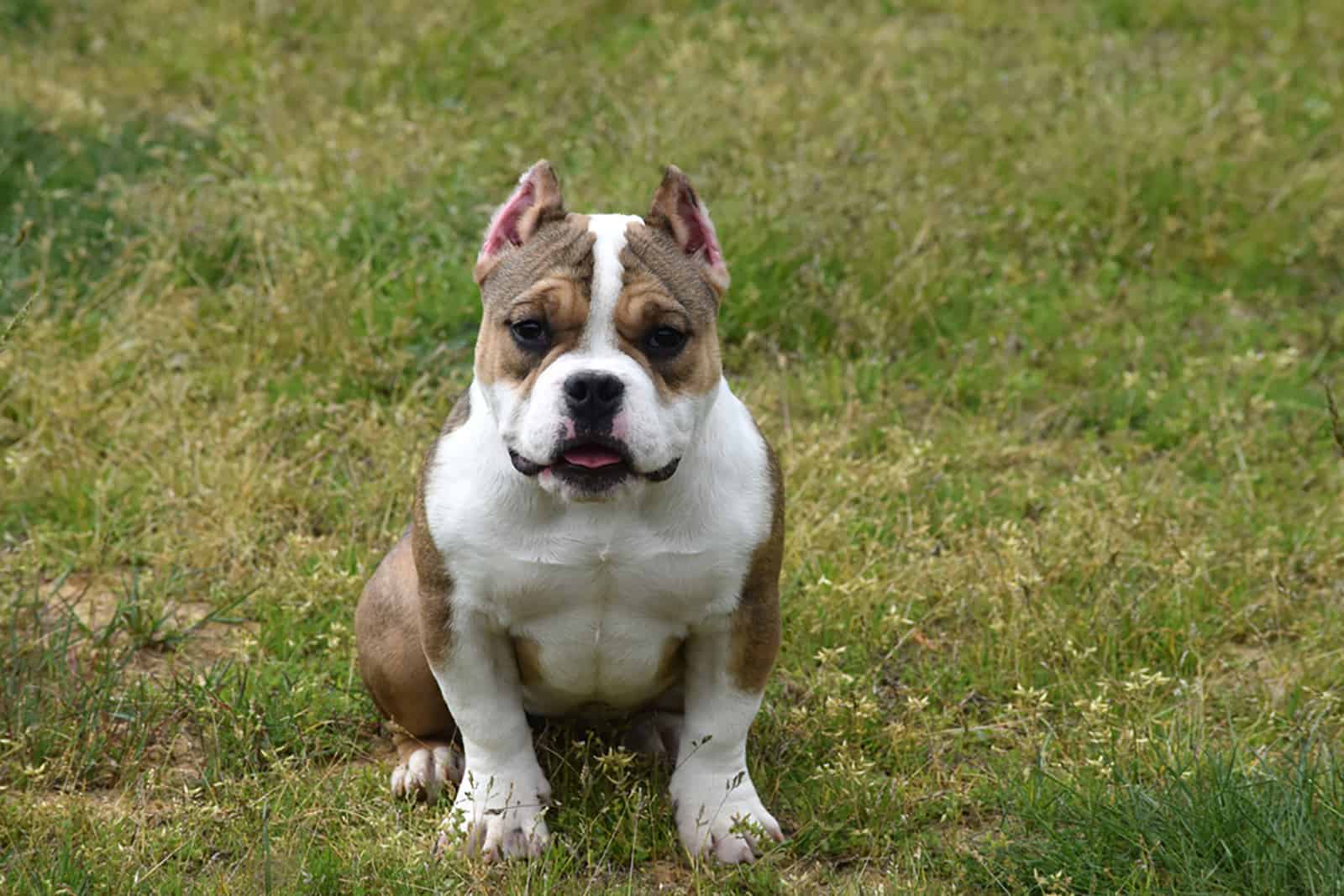American Bullies are stout little creatures. When you look at them, you see power and confidence in a pretty compact body. Colors play a role in the energy the dog radiates.
More colorful combinations can soften the look of a Bully and the tricolor Bully simply looks cuter.
If you are into having a strong and adorable American Bully, you will enjoy reading this article as we go deep into the genetic make-up of multi-color breeding. I am sure you have many questions, so let us start off with defining a tricolor Bully.
What Is A Tricolor Bully?
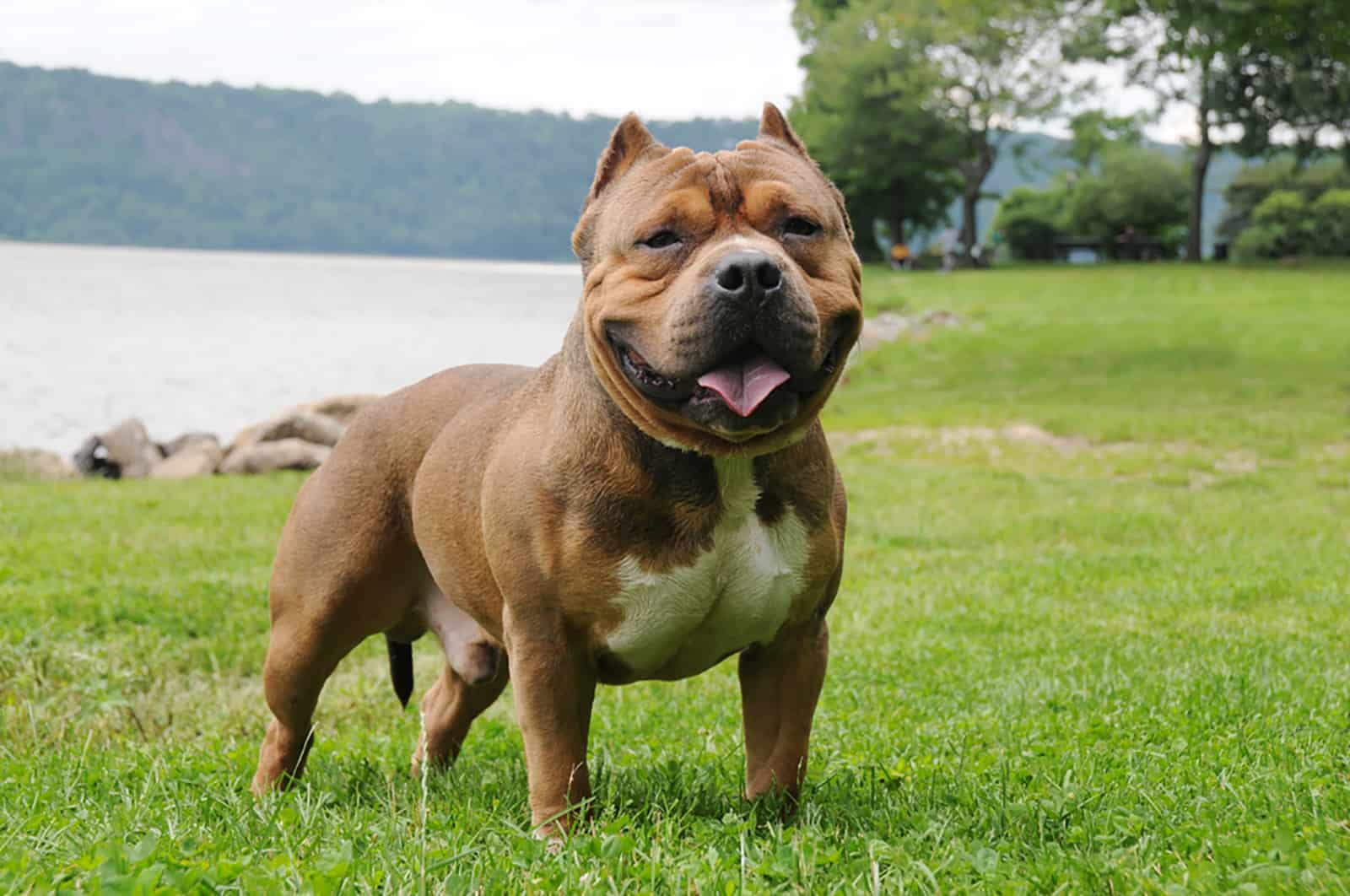
We have all seen American Bullies sport a single coat color and even two of them. Tricolored dogs are rare in general, but a bully puppy with a tri-color coat is something you will not find in many kennels.
The most common colors on a Bully are shades of gray or tan. The bi-colored Bully will often have some combination of tan or white with gray, black or some other color.
There are really rare bi-color Bullies, so you can imagine that three colors will be even rarer.
A Tri-color Bully will have a coat color with three different colors that need to have proper placement and be mutually proportionate. What proportions are those?
Well, the separation has to be clear and precise. Without tan points, a Bully will not be truly tri-color. The base color can vary, but the other two must be tan and white.
Needless to say, the base coat color can be any that is present in the Bully bloodline.
Most Bullies that are born with three coat colors are tri-color. However, there are exceptions to the rule. The exception concerns the color dissipation pattern. So, if one thing is not in the right place, it will not qualify for the tri-color title.
A white chest and neck and tan points above the eyes with a base color that extends like a blanket covering the outer part of the legs is the print that every Tri-color Bully must have.
Genetics Tell A Story About The Tricolor American Bully
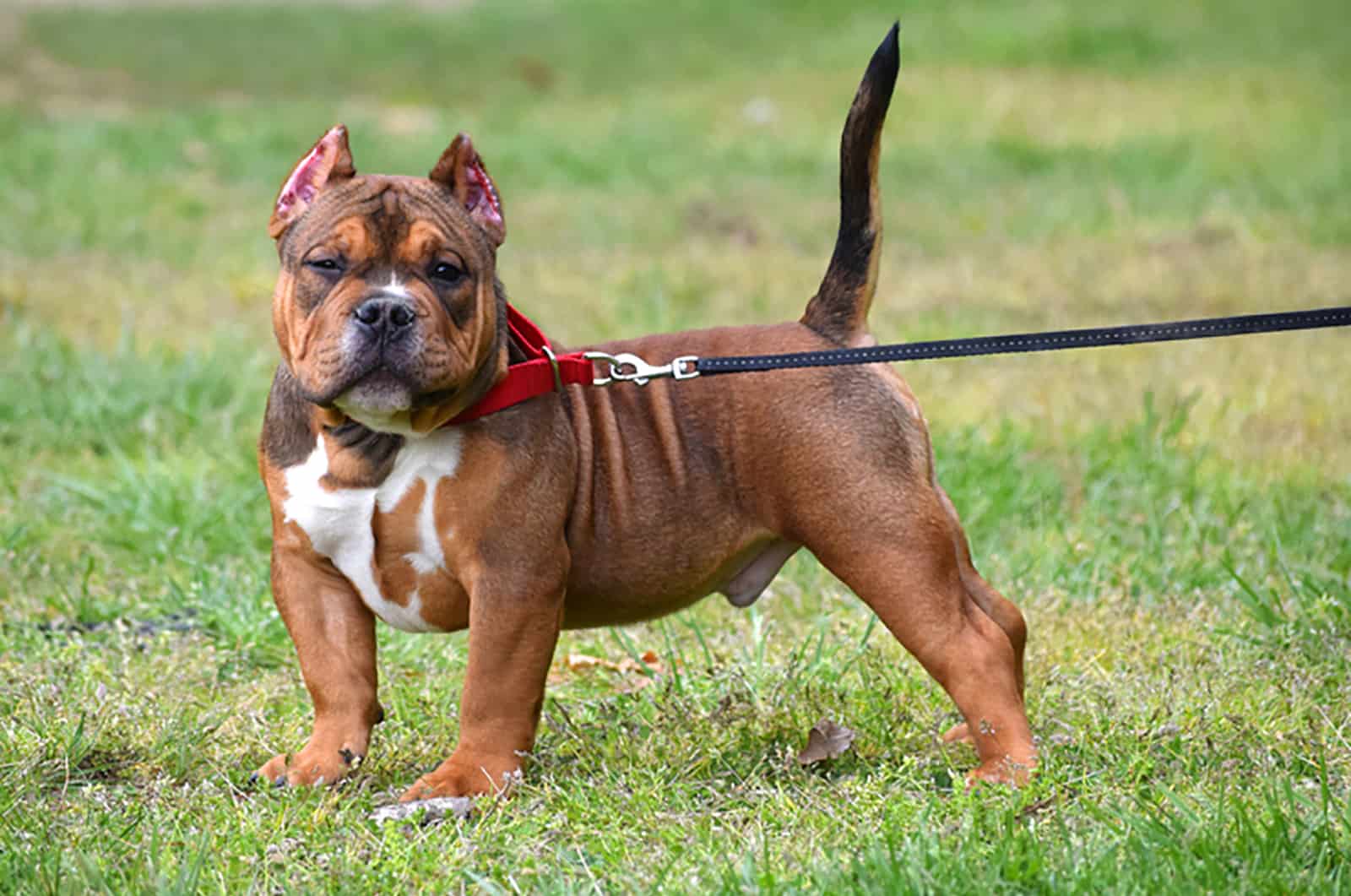
Tri-color Bullies are not nature’s creation. The environment dictates the evolution of your physical appearance for practical purposes. Breeders create these combinations to sweeten the deal for those looking for a unique looking dog.
How are colors in an American Bully connected to the rarity and exclusivity a Tri-color represents? It is all about the gene pool and gene series. The gene that is responsible for determining the Bully’s color is called an allele.
An allele is a variation of the gene that resides in a different locus (location inside the chromosome). Each parent gives one allele to the offspring. If the puppy inherits alleles from the same locus then it is homozygous for that particular allele.
The K Locus In American Bullies
The incompletely dominant allele in American Bullies is the K allele. It can yield colors other than black such as gray, chocolate and liver.
The percentage of the dominant black allele makes the color change. In essence, the K allele only masks other colors, and a lower percentage of K dominance means more visible secondary colors (markings or masks).
In American Bullies, the K locus has three allele types: K (black), kbr (brindle) and k (non black). If the K allele is dominant (Kk/KK) then the dog’s entire coat will be one solid color (eumelanin). White markings are possible with either combination.
Different genes can mix with eumelanin to give colors such as Isabella, blue or liver. Red and tan would not be present in this case.
If the Bully’s genetic test shows a kk results that means it will not be black. Instead, it will receive the color from the A locus allele. The color produced will be a combination of black/brown (K) and red/yellow (A).
Dogs with the kkbr or kbrkbr genetic combo will, again, get their color from the A locus and this will always yield a brindle color.
The A Locus In American Bullies
The members of the A locus are the following four alleles: Ay (sable), aw (agouti and wolf gray), at (tan point gene) and a (recessive black).
The sable is most dominant and coloring manifests itself on the head/ears, back and tail. The tan point allele is the one that creates a tri-color effect limits the occurrence of the phaeomelanin on the inner part of the legs, front of the chest, mouth and under the tail.
Dogs with a saddle or creeping tan showcase the tan point pattern which spreads with age. The recessive allele is extremely rare and causes the dog to be black, just like the K locus.
Phaeomelanin is not produced at all in dogs with the a allele.
The E Locus In American Bullies
Five alleles exist in the E locus: Em (eumelanin mask), Eg (grizzle or domino), Eh (Cocker sable), E (normal) and e (recessive red).
The eumelanin mask occurs on the muzzle and can also be found on the ears. Occasionally, a Bully will have Em that is shown on the chest and undertail. A normal E locus does not influence coloring.
A red recessive gene converts every last bit of eumelanin pigment into phaeomelanin. This always results in a solid red coat color. A bully with the e allele cannot have any amount of Isabella, black, liver or blue coloring.
The C Locus
Only one allele is present in the C locus and is also known as the Urajiro allele. It dilutes phaeomelanin so that only the points of the dog’s coat are affected. The dilute color is white or ivory but other pigments are unaffected.
This means that, if your Bully is Isabella, black, blue or liver, those colors will stay the same color without any dilution or discoloration.
The D Locus
Alleles D and d are in the D locus and the former controls how intensely the eumelanin is spread throughout the coat. This includes all parts of the body.
The d allele is a dilute while D is recessive. A dog will need to have dd to have dilute coloring. The Dd combination means that the dog only carries the gene but will not display its effects on the body.
Isabella and lilac colors are achieved by mating two Bullies with d alleles.
The S And T Loci
Locus S contains two alleles that affect markings and patterns. The S allele does not produce markings while the sp creates a pattern called piebald.
When a Bully has only a single copy of the sp allele, it will have much smaller white markings while two copies usually create piebald or albino white coats. Many other patterns can occur thanks to the sp allele.
Three alleles are present in the T locus: T (ticking), Tr (roan) and t (clear white). A very interesting fact of the T and Tr alleles is that the patterns (spots or splotches) are not present on the puppy but form as it gets older.
Merle Gene Explained
The merle allele is another incompletely dominant gene. There are two allele variations — M (merle) and m (non-merle). For your Bully to have the merle coloration or pattern, it would need to have only one parent with the M allele.
Double merle breeding is known as unethical as dilute pigment has some adverse and unwanted effects on many key systems in the body such as ears, eyes, skin, liver etc.
Possible Shades Of A Color Bully
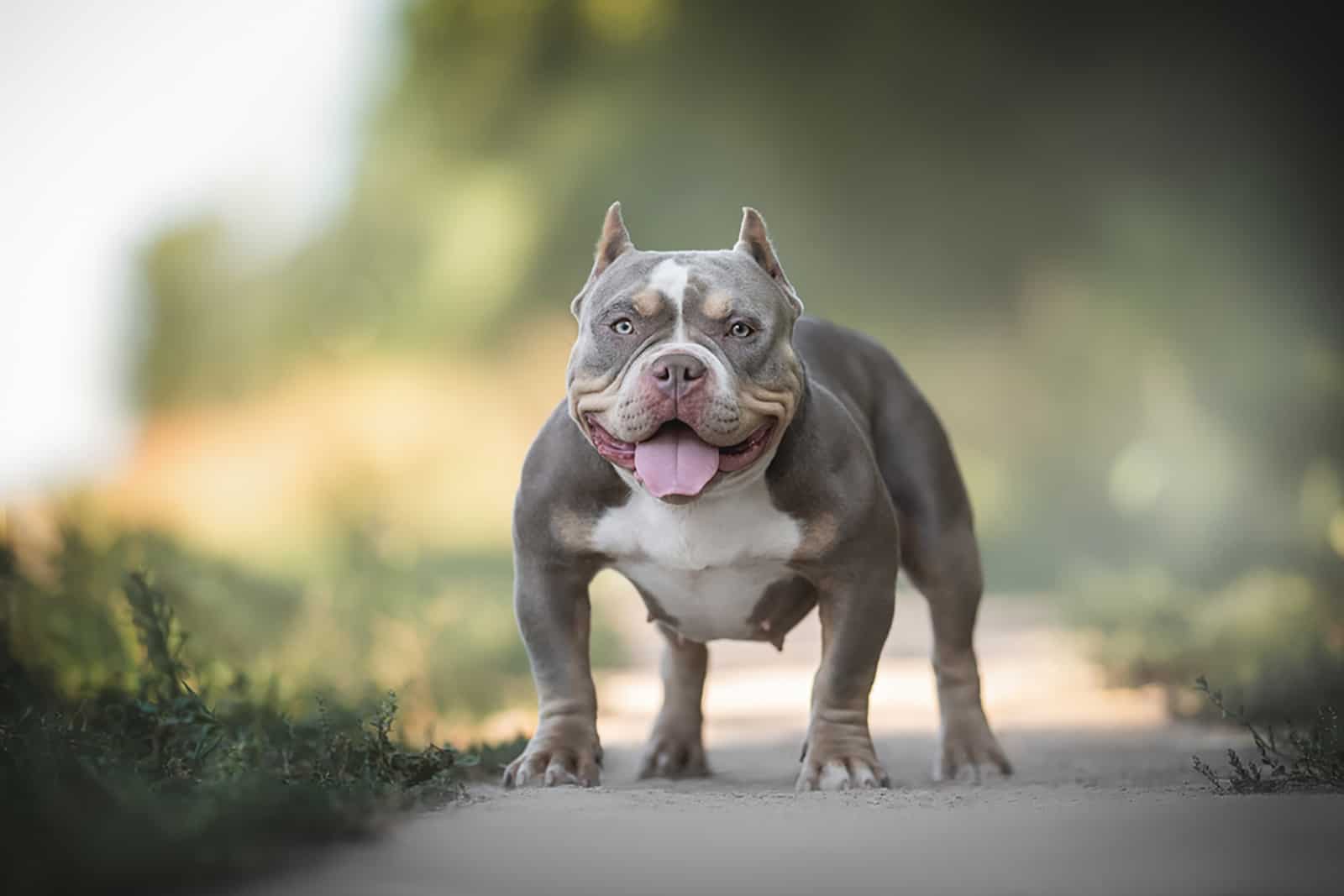
This is the fun part. When you know there are plenty of excellent options in terms of coat color, the excitement hits you really hard. So what tri-color coat patterns are available on an American Bully?Here is a list to get you started off.
1. Black Tri-Color Bully
I thought starting with the most common tri-color Bully would be appropriate. Do not mistake it for a common Bully color/pattern — this is simply a base color that occurs quite frequently.
Long story short, a white chest with tan points above the eyes and legs with a black blanket covering the back, sides and outer part of the legs is a black tri.
2. Blue Tri-Color Bully
https://www.youtube.com/watch?v=30NzIjwd11I
The dilute gene causes the black color to appear bluish despite it actually being gray. There will still be colored markings on the chest, legs and muzzle.
A blue tri requires allele combinations that are hard to achieve so it is particularly difficult to breed and find.
3. Green Tri-Color Bully
Green would not be the most precise description of the color, but the alleles involved cause the dilute black and yellow to mix. This gives the impression of a green coat. Markings of other colors remain intact on a green tri.
4. Red Tri-Color Bully
Red recessive genes give the red tri the reddish or brown coat color. Markings still remain unchanged.
5. Lilac Tri-Color Bully
The lilac tri is even rarer than the blue tri. The process behind the color is exactly the same though — dilute chocolate or brown becomes liver and it combines with the dilute black (blue) to achieve the “lilac” shade.
6. Ghost Tri-Color Bully
The absence of the black dominant gene causes only the points of the hair on a dog’s coat to become dilute giving it a “ghostly” transparent look.
7. Brindle Tri-Color Bully (Trindle)
This combination of brindle pattern (brown or chocolate base with dark stripes) and tan point gene is exceptionally good looking but equally rare too. An American Pitbull Terrier (not a Bully) is commonly seen in this combination.
8. Piebald Tri-Color Bully
Also known as the tuxedo pattern, the piebald is characterized by a combination of white and black. In Tri-colors though, the markings are displayed in a third color.
9. Champagne Tri-Color Bully
The tan base color is slightly dilute and gives the appearance of a “champagne” color. It is among the rarer tri-color options but not as rare as the blue or lilac.
10. Fawn Tri-Color Bully
This tri-color Bully is characterized by a brownish coat color with usually white marks on the head, chest and legs.
11. Tri-Merle Bully
If you are looking to get the most rare and unique tri-color combo, this is your ticket to victory. A combination of black, white and gray with blue eyes ought to look striking on a Bully.
12. Buckskin Tri-Color Bully
Buckskin is a particular shade of tan with yellow throughout the base color. A tri American Bully with this color mix can often be mistaken for an American Pitbull Terrier.
13. Chocolate Tri-Color Bully
Everybody likes chocolate, so you will be happy with a choc base coat with different color markings. It is usually paired with tan and black coloring on the head, chest and legs. This type of color in a Tri-color Bully is caused by the K locus allele.
Are Tri Color Bullies Rare?
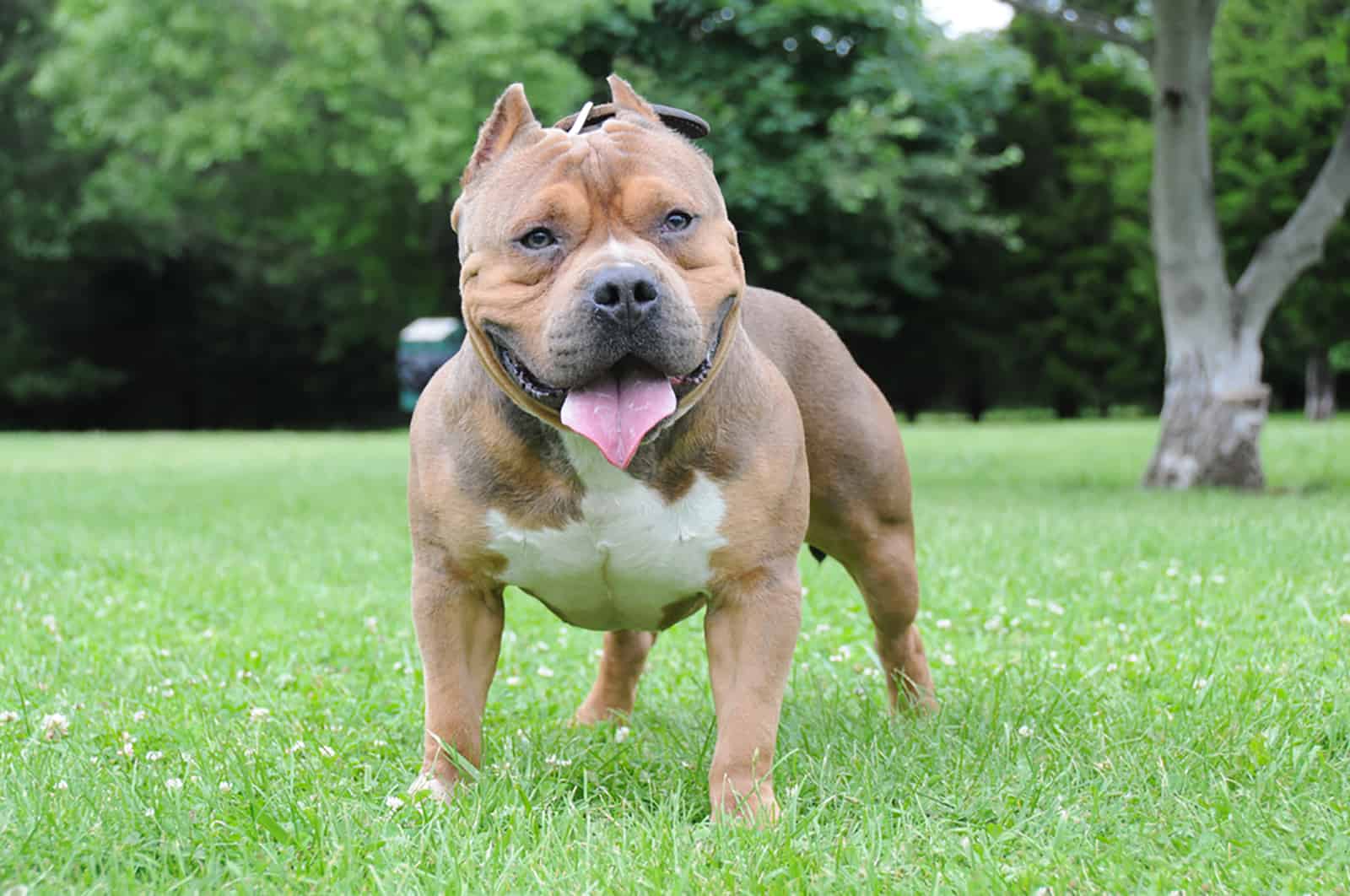
Yes, they are rare, but it highly depends on the combination you are looking for. Some American Bully puppies that sport a tri-color coat like the roan or piebald tri Bully, will start developing the pattern with age.
This means you will now know what kind of Bully you are getting.
If the Bully breeder does a genetic test or they know the genetic results of the puppy’s parents, you can have a pretty good idea what type of pattern your tricolored puppy will sport.
The blue, lilac, ghost and tri-merle are the rarest out there. You will be lucky if you find one.
Make sure you research a bully breeder that claims to have them since these tri-colors, especially the tri-merle, are often bred unethically and their origin can be suspicious.
How Much Is A Tri Color Bully Worth?
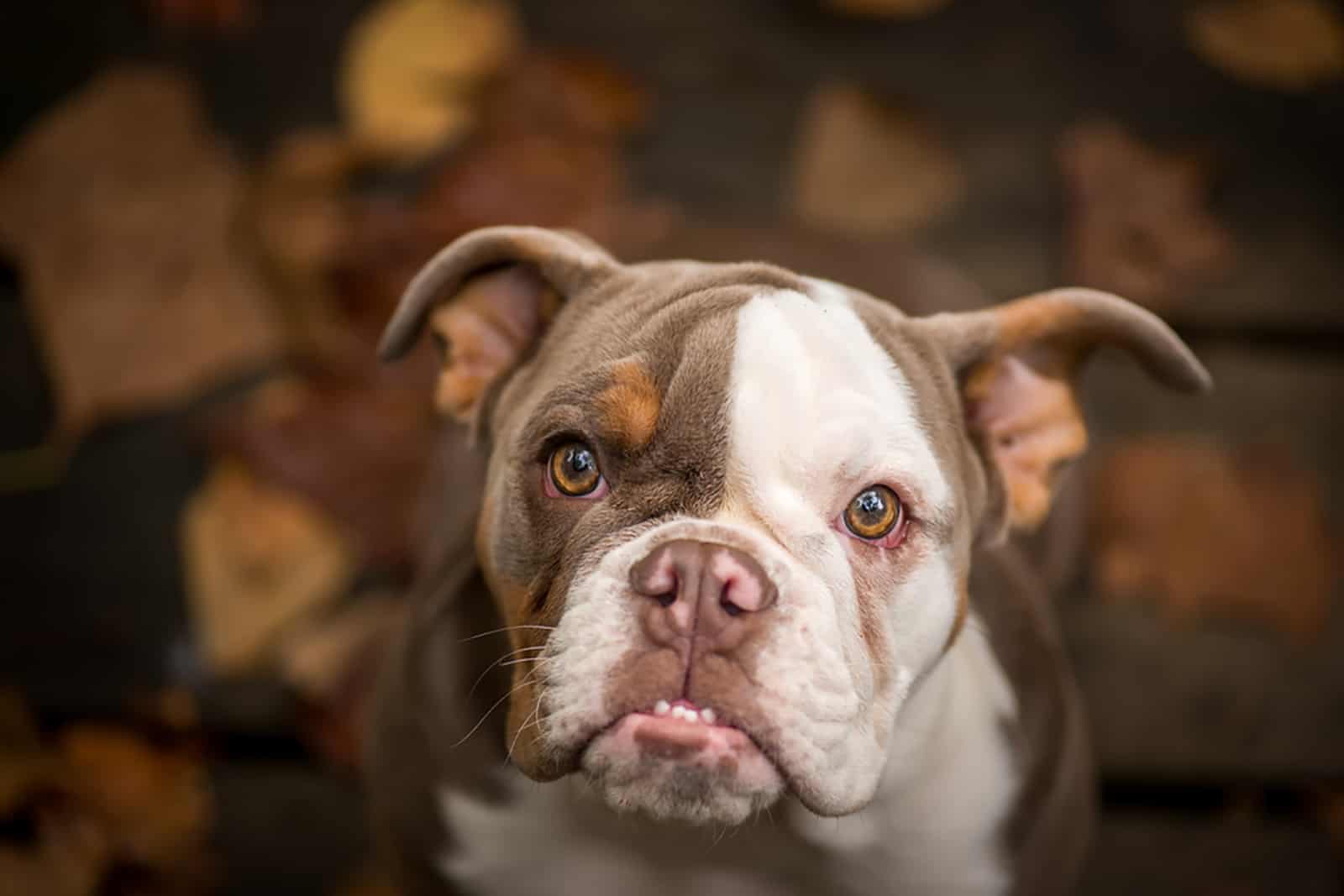
Tri-colors love dependencies, do they not? There are significant price differences between tri-color combinations, so take a look at the table below showcasing prices for some of the color mixes.
Another important thing is the selection of breeder. Not every bully breeder will value their puppies the same. Thanks to the rarity of many of the tri-color options, they (breeders) can go as low or high as they want with pricing.
Tri-Color Combination Price
Black Tri $4000-$6000
Blue Tri $5000-$7000
Brindle Tri $6000-$8000
Choco Tri $5000-$7000
Lilac Tri $8000-$12000
Ghost Tri $10000-$15000
Piebald Tri $6000-$8000
What Breeds Make A Tri Bully?
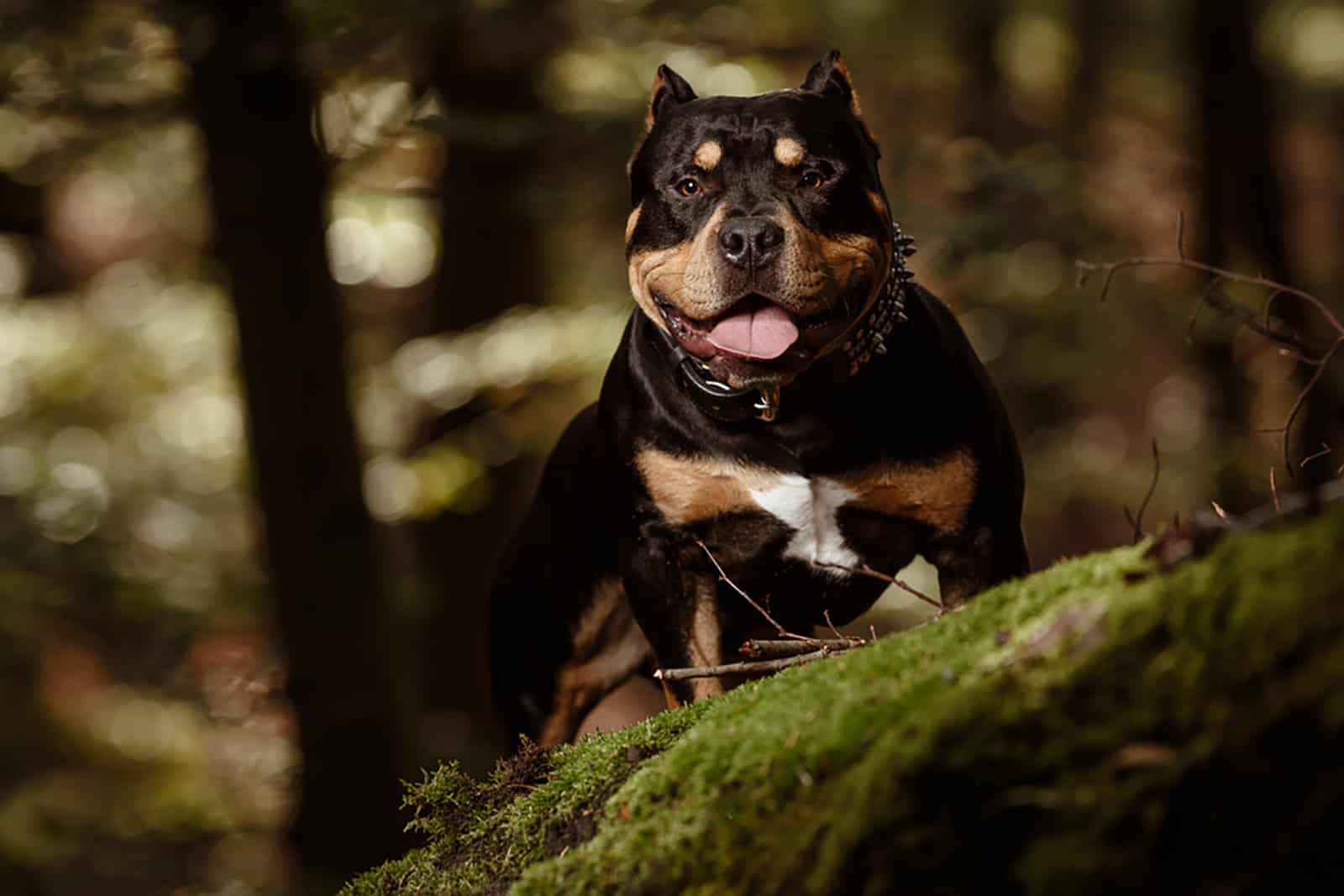
American Pitbull Terriers and American Staffordshire Terriers combined with different types of Bulldogs are the basic formula for getting an American Bully. The standard Bully has short legs with a very muscular body.
The American Bully Kennel Club (ABKC) defines the XL Bully as the same breed mix as the standard Bully. The major difference is, as the name suggests, the size and weight. Only the largest Bully dogs were selected for mating to produce the XL.
Simlarly, the smallest representatives of the Bully breed were mated to create a dog that is primarily a companion dog — the Pocket Bully. These dogs are smaller in size and weight than the standard Bully.
Exotic things are very popular nowadays, hence the existence of the Exotic Bully. What makes it exotic? The over the top physical features.
Four breeds were necessary to produce this mix: Standard American Bully, French Bulldog, English Bulldog, and the Olde English Bulldogge.
What Is A Tri-Color Bully’s Personality Like?
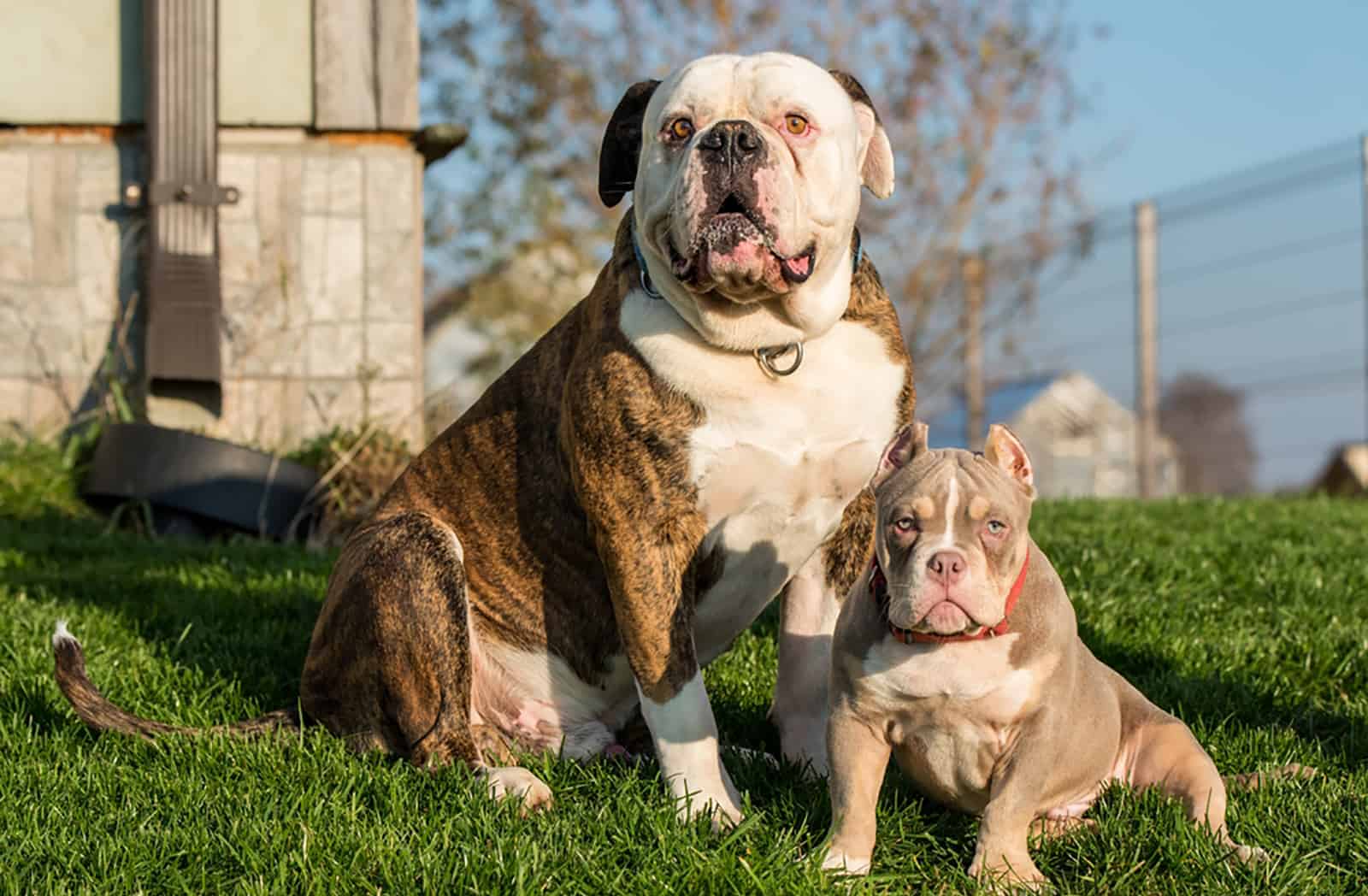
If you ever came across an American Bully, then you will be familiar with every Tri-Color Bully too. They are big people pleasers. Why? Well because they are a mixed breed that has some very obedient dog breeds in the bloodline.
The American Bully breed can be a cross of many different breeds but they are most often bred with American Staffordshire terriers or American Pitbulls and one of a wide variety of Bulldog breeds.
If you want to know more about these mixes visit our American Bully Mixes article.
Thanks to the Bulldog lineage, they can sometimes be stubborn but, mostly, love to do stuff that makes the owner happy. This is another reason they can be mistaken for a Tri-Color Pitbull.
Tri Bullies are surprisingly energetic considering their very muscular body. The short legs can be deceiving thinking you could outrun them. Bad news — you cannot.
They have great prey drive too so that might be the reason behind their focused squirrel chasing.
In addition to that, they love their families and are ready to give their life protecting them. This should not discourage you from having guests around.
They are very sociable and gentle, although, wary of strangers who like to make a bombastic entrance.
Early socialization is necessary to avoid possible mishaps in the future. Their relentlessness can become aggression if not adequately trained.
They are very smart (if you have not figured it by now) and will be a big challenge for first time dog owners.
Health Issues In Tri-Color Bullies
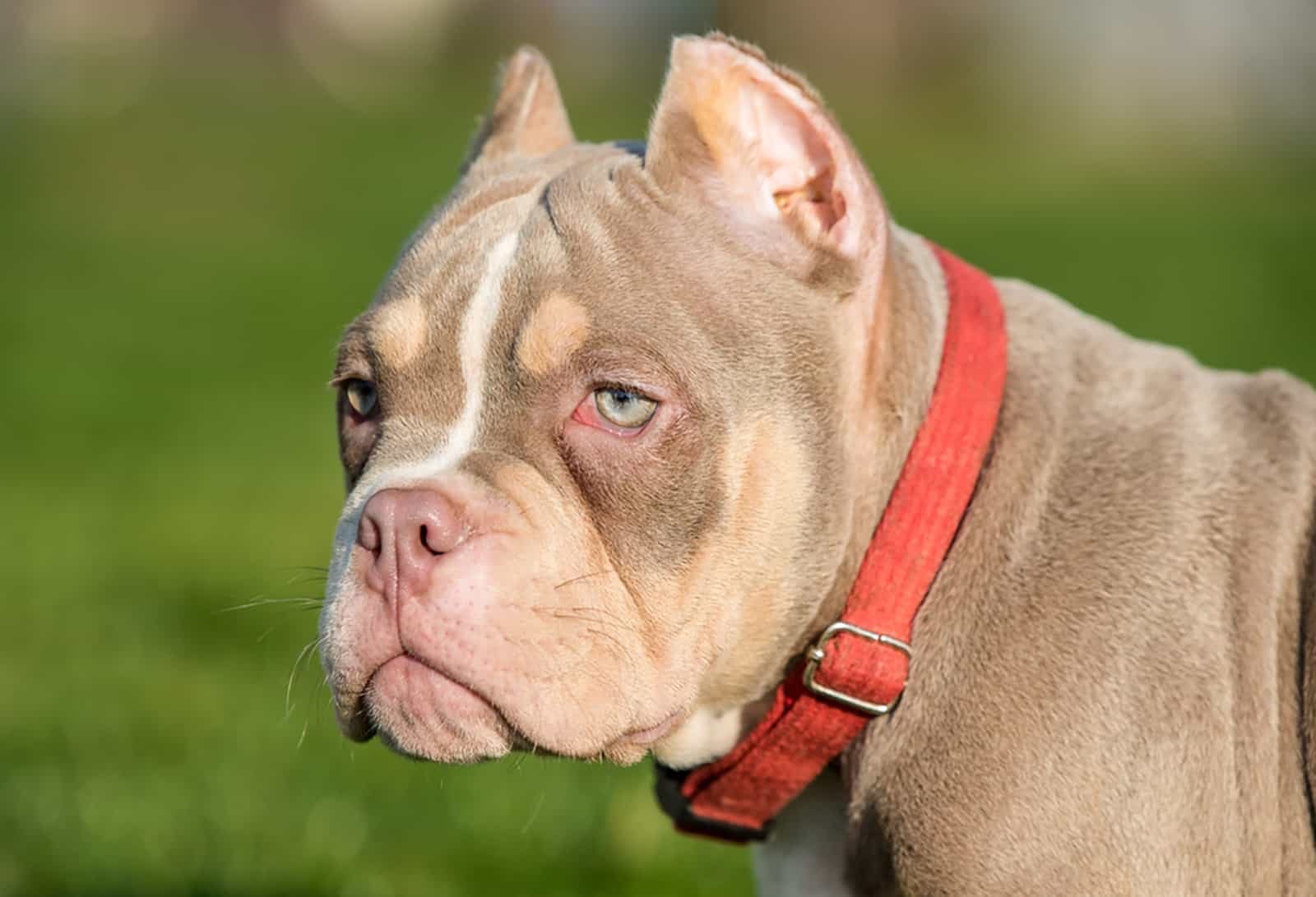
Unfortunately, this part of owning an American Bully is a reality we have to accept. Still, it is better to be prepared in case something happens. I hope nothing bad ever happens to your dog, but here are some health issues to keep an eye out for.
Hip Dysplasia
Damned dysplasias… they seem to pester every dog. Dysplasia is a congenital condition most often caused by bad genetics in puppy parents.
When the end of the hip bone (femur) and the hip socket are misaligned, the bone tissues grind against each other causing inflammation.
The condition can be worsened by physical activity when the symptoms are mild or barely visible. For more severe cases, the only treatment is surgery that can even include expensive hip replacement. Pay attention to symptoms such as difficulty moving or disinterest for exercise.
Hypothyroidism
This condition is characterized by the thyroid gland not producing enough thyroxine and triiodothyrone. These two hormones combined control many important body functions such as metabolism, body temperature and kidney activity.
Since this condition is not uncommon in dogs, the treatment includes the veterinarian prescribing synthetic hormones to make up for the thyroid’s underproduction.
If you see your Tri-color Bully becoming lethargic, overweight or its coat starts changing contact an MVD.
Allergies
Brachycephalic dogs are prone to allergies more than other dog breeds. The airway problems caused by the anatomy of the nose makes it hard for them to sneeze out the inhaled allergens.
The prolonged exposure to them enables allergen entry into the bloodstream.
This, in turn, creates problems with the skin (most common), coat, breathing and can affect other organs such as kidneys and liver.
Conclusion
Now that you set your eyes on the best Tri-color Bully it will be a matter of finding a reputable breeder that has some colorful puppies. The alleles and loci will not play a role in the Bully’s temperament but can make you like the dog more.
A word of warning regarding tri-merle Bullies: merle is a gene that is often associated with many congenital health issues and there are studies that confirmed it.
However, since the tri-merle can be produced with only one parent having the merle gene, you should be safe.
Two merle parents can be a disaster waiting to happen so avoid breeders that practice unethical double merle breeding.
Consider the price before buying as the upkeep of these dogs is quite high without the initial cost too.
My recommendation if you plan on spending upwards of five thousand dollars for a Tri-color Bully is to RESEARCH breeders until you cannot stand seeing the word Tri-color.
You will find it much more rewarding if your dog is free of health problems and looks amazing at the same time.
Keep researching and may you choose the Tri-colorest Bully in the universe.
